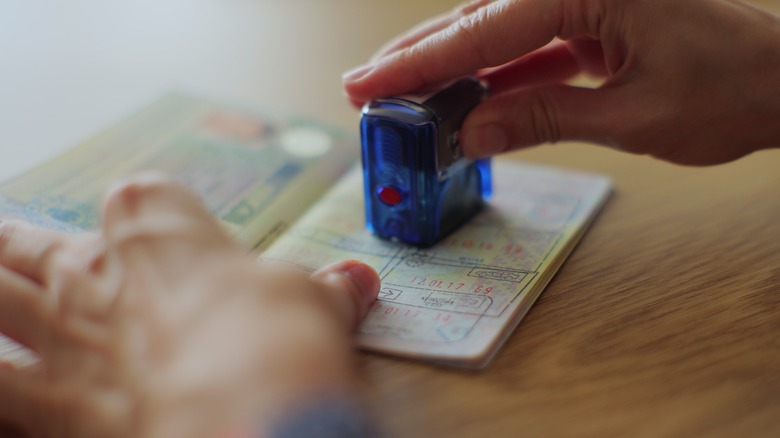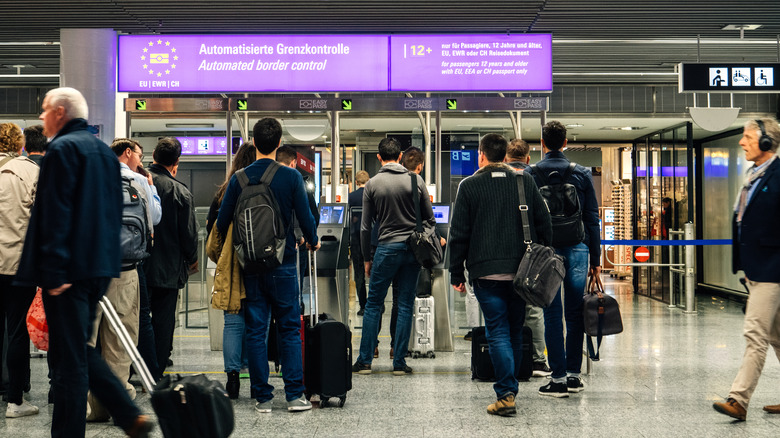European Union Passport Stamps Are Coming To An End. Visit Before This Date To Get One
For decades, passport stamps have been a cherished memory for travelers, with each one marking a new adventure — a physical reminder of all the places you've visited and all the experiences you've had. But now, for those traveling to the European Union, the days of collecting these inked impressions are numbered. With the upcoming implementation of a new system, traditional passport stamps will soon become a nostalgic thing of the past. If you're a fan of passport stamps as travel souvenirs, there's a limited window to get one on your next trip to Europe — before it's goodbye, forever.
The European Union is set to launch its Entry-Exit System (EES) on November 10, 2024, a significant overhaul of how the region manages and monitors the movement of non-EU travelers. This system, which will be entirely electronic, is designed to secure the EU's borders by digitally recording the entry and exit of each and every traveler who doesn't hold an EU or Schengen citizenship. EES will replace the "old-school" practice of stamping passports with a more efficient, secure, and streamlined process. After all, Europe receives over 700 million tourists yearly — it's not easy to keep up (via Statista).
Under the new system, non-EU travelers entering the Schengen Area — a zone that includes 29 European countries that have abolished passport control at their mutual borders — will have their biometric data recorded electronically. "The system will register the person's name, type of the travel document, biometric data (fingerprints and captured facial images), and the date and place of entry and exit, in full respect of fundamental rights and data protection," reads the official statement by the European Union Migration and Home Affairs department.
Entry-Exit System (EES): A new era of European border control
This change is part of a broader effort in Europe to enhance security, prevent irregular migration, and track overstays more effectively (another reason why proof of onward travel is always required when taking an international trip). Non-EU citizens cannot stay in the Schengen Area longer than 90 days in any 180-day period. The new system will also make it very difficult — if not impossible — for terrorists, people with criminal associations (including crime suspects, perpetrators, and victims), and anyone partaking in espionage or traveling with a fake passport to enter Europe.
According to an Entry-Exit System factsheet, the process of this new automated system is quite straightforward. Upon landing, travelers will submit all necessary ID verifiers at a self-service kiosk, where the system will cross-reference the documents against various security databases, like the Schengen Information System (SIS) and Interpol's Stolen and Lost Travel Documents (SLTD). The only parties with access to your data are border guards, consular officers, law enforcement authorities of member states, and Europol. If something sets off an alarm, border guards will step in. If all is well, welcome to Europe! EES will be active at every airport, harbor, and road border crossing.
Understandably, some globetrotting travelers may be very dismayed to hear this news. After all, for many, passport stamps are a cherished part of the travel experience (not just a formality). The thrill of seeing a new stamp added to your passport or the nostalgia of flipping through pages filled with stamps from past journeys bears a palpable romance and wanderlust. Other travelers — even members of the airline industry and some countries — believe that the EES system will become a logistical nightmare that will only cause more confusion and problems once it officially rolls out.
Getting your last EU passport stamp
With the EES set to go live in November of 2024, travelers have a limited time to get their passport stamped when entering the European Union. Travelers planning a trip to the EU should aim to visit before November 10 if they want to add a European passport stamp to their collection. Once EES is in place — and fingerprint scanning becomes the new normal — passport stamps will no longer be issued at EU crossings (not even if you ask the border guard nicely).
Here is the good news: Now is the perfect, time to plan a last-minute trip to the European Union. Consider visiting some of its most iconic destinations — take in the romantic charm of Paris, the stunning landscapes of the Swiss Alps, or the vibrant culture of Berlin. Those who want to make the most of this last-chance opportunity should consider embarking on a multi-country trip within the Schengen Area. These final EU passport stamps will become a meaningful keepsake of your European trip, the last of its kind.
While the end of passport stamps may feel like the closing of a chapter, EES will mark the beginning of a new chapter in European travel. Security will be better, waiting times at border crossings will be shorter, and the travel experience will be more seamless for everybody, with fewer delays and less hassle when entering and exiting the Schengen Area. The final countdown is here; this is the end of an era. Get your European stamps while you still can!


